Main Content
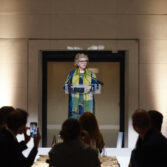
The Design Effect: DBA Chief Executive’s speech
The 2024 DBA Design Effectiveness Awards were presented at The Design Effect, a new event from the DBA celebrating and exploring the impact of design on business, society and beyond. Held at The British Museum on Tuesday 8 October, the inaugrual event featured speakers including Monzo’s Vuokko Aro, Wolff Olins’ Sairah Ashman, Diageo’s Jeremy Lindley and Sir Geoff Mulgan.
How can design help navigate the biggest shifts our world faces?
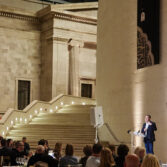
No ordinary industry event, The Design Effect was a unique and inspiring afternoon and evening of talks, panel debates, effectiveness case studies and dinner discussions in the spectacular surroundings of The British Museum.
Senior leaders from companies like Carlsberg, NatWest, Pearlfisher, Bayer, Danone, Osborne Pike, 2LK, Volvo, Nestlé, ELSE, Reckitt, Wolff Olins and more, fired up their passion for what design can achieve and left ready to change tomorrow.
The Design Effect was opened by the DBA’s Chief Executive Deborah Dawton and featured a keynote speech in the British Museum’s Great Court by Sir Geoff Mulgan, author of ‘Another World is Possible’.
Take a peek into the day, see who won DBA Design Effectiveness Awards and read Deborah Dawton’s speech below.
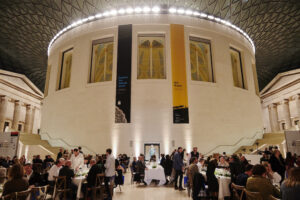

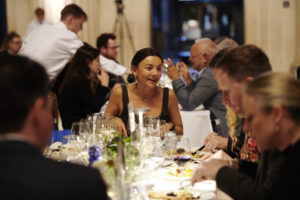
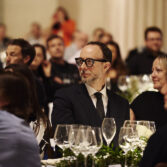
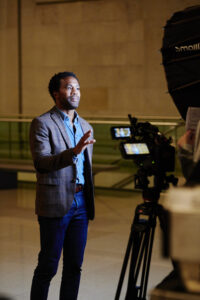
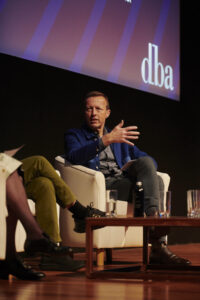

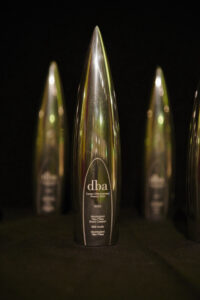
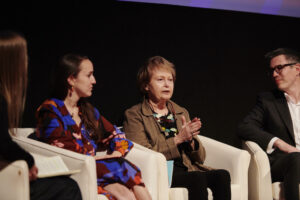

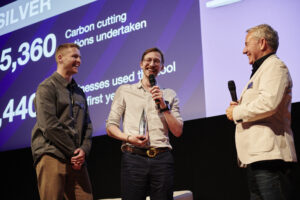

DBA Chief Executive's speech transcript
 “Welcome to The Design Effect. My name is Deborah Dawton and I’m the Chief Executive of the Design Business Association, and it’s my privilege to welcome you here today.
“Welcome to The Design Effect. My name is Deborah Dawton and I’m the Chief Executive of the Design Business Association, and it’s my privilege to welcome you here today.
When Adam (Fennelow) and I are talking to business leaders about joining the DBA, one of the propositions that we put to them is that they should join the DBA if they want to be the architects of their own future, of the future of the design industry.
Adam we’ve got this wrong!
It’s not nearly a big enough goal, given the capability of impact and influence this sector of ours could be having. Surely our goal should be much much more ambitious. Being the architects of THE future is what we should have a concern for, because if we’re not, who is?
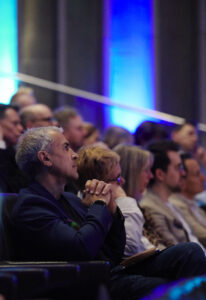 I’d like to read you a bit of a story in a magazine I get – it’s the October edition of The Simple Things magazine, and it’s about the legacy of the textile industry. Picture sheep in fields and in the distance a prosperous town boasting great housing of the time, and a spectacular church or two, and a guildhall.
I’d like to read you a bit of a story in a magazine I get – it’s the October edition of The Simple Things magazine, and it’s about the legacy of the textile industry. Picture sheep in fields and in the distance a prosperous town boasting great housing of the time, and a spectacular church or two, and a guildhall.
The article starts, “Woven into the British Isles is the story of our textiles. And traces of this history are found everywhere, from sheep that graze our hills to the mills that skim our skylines. These threads take us from farms to weavers to merchants, and from towns and villages to all over the world. They’ve shaped grand civic buildings and humble domestic dwellings; we’ve used natural resources to power production and brute force to build railways and canals for transportation. There are specific local histories – such as Dundee’s jute, Welsh tapestry blankets, and the ganseys of the Shetland Isles and coastal communities. Then there are the specialist trades, such as lace, silk, dyeing and finishing.”
Take wool. “In medieval times, wool was one of the most important contributors to the English economy. The likes of the Church of St Peter and St Paul, in Northleach, in the Cotswolds, rebuilt with wool money in the 15th century, is just one of the many gilded reminders of the spectacular wealth generated by wool. Families who grew rich rearing sheep, trading fleeces or weaving wool, made generous contributions to the church, often creating places of worship completely out of scale with modest village congregations. Their building also supported hundreds of crafts people, from stonemasons to stained glass makers.”
The article goes on to say that you can see wool’s influence in the sheep you’ll spot such as Herdwick and Welsh Mountain, whose coarse wool makes it more suitable for use in carpets, or the softer fleeces of lowland sheep, such as Ryland and Suffolk, and the longwool breeds, like Bluefaced Leicester and Wensleydale, that find use in knitting yarns. And it also  goes on to tell you how surviving packhorse routes show the journeys undertaken to take the wool from sheep to weaver to merchant, such as Norfolk’s Weavers’ Way, winding between Great Yarmouth and Cromer. And you’ll be familiar with the fact that these yarns were woven into very different textiles often influenced by place – look at the colours of tweed and tell me those aren’t the colours of Scotland, and those colours were most often created by dyes made from plants and berries found in those places.
goes on to tell you how surviving packhorse routes show the journeys undertaken to take the wool from sheep to weaver to merchant, such as Norfolk’s Weavers’ Way, winding between Great Yarmouth and Cromer. And you’ll be familiar with the fact that these yarns were woven into very different textiles often influenced by place – look at the colours of tweed and tell me those aren’t the colours of Scotland, and those colours were most often created by dyes made from plants and berries found in those places.
Reading this got me thinking. What will the legacy of the design industry be?
If I was reading this article about all of us 50 years from now, what would it say? Let’s bring that forward. What would it say in 2035? 10 years from now. What do we want it to say, because that article would be talking about us.
The textile industry built towns, better living conditions, churches , guild halls, markets to sell goods, and so on. And I know I’m giving you the version of their history that is rose-tinted, but it’s to make the point.
What do we want our legacy to be?
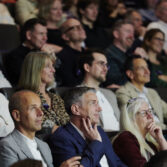 Do we think and exist beyond the immediate design challenge?
Do we think and exist beyond the immediate design challenge?
Is there a thread of altruism that runs through this industry, a generosity of spirit? There is in all of you – you’ve given your time today to come together around a common purpose. We’re here today because we want to weave a closer association across the design industry.
But, I also want to challenge you to exercise your imagination to its full potential, in order for you to be able to put yourself far ahead of what your designing today.
My suspicion is that we’ve all had our heads down focusing on what we’re designing now, and I think we need this event today to encourage us to change our perspective. This isn’t about look up and look out. I need you living in the “out” bit. Out there looking back.
Having that perspective on the future is now critical – it has to be a part of who you are. We cannot continue to design despite it, the future that is.
Design will save the world has been the matra coming out of our sector for the last 25 years. You know, pants outside your trousers stuff.
In the same way that a piece of fabric won’t clothe someone, but it allows you to make the garments that will clothe people, design allows companies to make products and services that can have an impact.
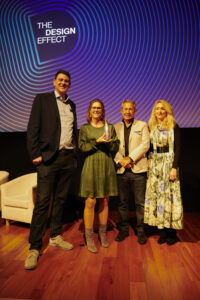 The Design Effectiveness Awards, and this event today, The Design Effect give us the case studies that are historical evidence – there was a brief, there was a design, it went to market, it was in market for 3 years and this was the impact.
The Design Effectiveness Awards, and this event today, The Design Effect give us the case studies that are historical evidence – there was a brief, there was a design, it went to market, it was in market for 3 years and this was the impact.
My call to you today is that you take confidence in knowing that that will happen. But… design is just one component of that reality.
Designers need to exist beyond their designs – you need to imagine five years after the launch. It’s where you need to be. You shouldn’t have to be told to look up and look out, you should already be in the future. Yes we operate in the creation of something today but our responsibility is to sit in that forward state and consider the implications of what we’re designing.
In order for us to have a better sense of what the future is, we need to be better woven together. We need to be congregating, discussing, debating, showing and telling. Challenging each other.
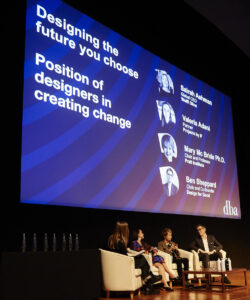
And where has the concept work gone everybody? It was concept work that got SeymourPowell on our TVs 25 years ago. It was house of the future that attracted 250,000 through it at the Ideal Home Show years ago. What are our concepts around sustainability? Around equality. Around diversity. Where can we be seen taking responsibility for the future? With no flag in the sand, what are we aiming for?
I’d love us be presenting our concepts of the future the next time we meet, interwoven with the case studies of our proven successes. And I’m talking about the opposite of nudge here! Nudge ignores our ability to create. But the power to draw people into our future lies with us – to draw alongside, because when we’ve suggested what the future looks like, it’s less risky for those that need to step into it, the businesses we work with. There can be no more design in isolation. We must draw together if we’re going weave the right narrative of the future, a future we’ve designed.
And just maybe, our legacy will be a good one.”
Design Week’s Clare Dowdy summarises Four Takeaways from The Design Effect event.
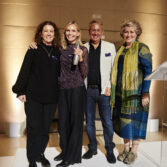
Spanning work for global companies, major retailers, start-up challengers and beyond, the 2024 DBA Design Effectiveness Award winners have been revealed. The Awards celebrate the integral role design plays in transforming businesses, improving societies and enhancing people’s lives. Judged by a broad range of business leaders and entered jointly by client and designer, this year’s Awards were presented at The Design Effect. Find out who won.
Browse all the Gold, Silver and Bronze award winning case studies here >